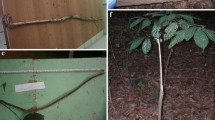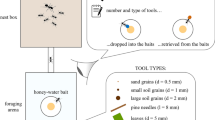Abstract
Honey-gathering from bee nests has been recorded at chimpanzee (Pan troglodytes) study sites across tropical Africa. Different populations employ different strategies, ranging from simple ‘smash-and grab’ raids to use of sophisticated tool-sets, i.e., two or more types of tool used sequentially in a single task. In this paper I present evidence of tool-use, and the probable use of a tool-set, for honey-gathering by unhabituated chimpanzees at Bulindi, a forest–farm mosaic south of the Budongo Forest in Uganda. Between June and December 2007, 44 stick tools were found in association with 16 holes dug in the ground, corresponding to the period when stingless bees (Meliponula sp.) appeared in chimpanzee dung. In 11 cases the confirmed target was a Meliponula ground nest. Two potential tool types were distinguished: digging sticks encrusted with soil, and more slender and/or flexible sticks largely devoid of soil that may have functioned to probe the bees’ narrow entry tubes. Reports of chimpanzees using tools to dig for honey have been largely confined to Central Africa. Honey-digging has not previously been reported for Ugandan chimpanzees. Similarly, use of a tool-set to obtain honey has thus far been described for wild chimpanzee populations only in Central Africa. Evidence strongly suggests that Bulindi chimpanzees also use sticks in predation on carpenter bee (Xylocopa sp.) nests, perhaps as probes to locate honey or to disable adult bees. These preliminary findings from Bulindi add to our understanding of chimpanzee technological and cultural variation. However, unprotected forests at Bulindi and elsewhere in the region are currently severely threatened by commercial logging and clearance for farming. Populations with potentially unique behavioral and technological repertoires are being lost.





Similar content being viewed by others
References
Bermejo M, Illera G (1999) Tool-set for termite fishing and honey extraction by wild chimpanzees in the Lossi Forest, Congo. Primates 40:619–627
Boesch C, Boesch H (1990) Tool use and tool making in wild chimpanzees. Folia Primatol 54:86–99
Boesch C, Head J, Robbins MM (2009) Complex tool sets for honey extraction among chimpanzees in Loango National Park, Gabon. J Hum Evol 56:560–569
Brewer SM, McGrew WC (1990) Chimpanzee use of a tool set to get honey. Folia Primatol 54:100–104
Caldecott J, Miles L (eds) (2005) World atlas of great apes and their conservation. University of California Press, Berkeley
Chapman CA, Naughton-Treves L, Lawes MJ, Wasserman MD, Gillespie TR (2007) Population declines of colobus in western Uganda and conservation value of forest fragments. Int J Primatol 28:513–528
Deblauwe I (2006) New evidence of honey-stick use by chimpanzees in southeast Cameroon. Pan Afr News 13(1):2–4
Deblauwe I, Guislain P, Dupain J, Van Elsacker L (2006) Use of a tool-set by Pan troglodytes troglodytes to obtain termites (Macrotermes) in the periphery of the Dja Biosphere Reserve, southeast Cameroon. Am J Primatol 68:1191–1196
Fay JM, Carroll RW (1994) Chimpanzee tool use for honey and termite extraction in Central Africa. Am J Primatol 34:309–317
Fowler A, Sommer V (2007) Subsistence technology of Nigerian chimpanzees. Int J Primatol 28:997–1023
Gruber T, Muller MN, Strimling P, Wrangham R, Zuberbühler K (2009) Wild chimpanzees rely on cultural knowledge to solve an experimental honey acquisition task. Curr Biol 19:1806–1810
Hernandez-Aguilar RA, Moore J, Pickering TR (2007) Savanna chimpanzees use tools to harvest the underground storage organs of plants. Proc Natl Acad Sci USA 104:19210–19213
Hicks TC, Fouts RS, Fouts DH (2005) Chimpanzee (Pan troglodytes troglodytes) tool use in the Ngotto Forest, Central African Republic. Am J Primatol 65:221–237
Hunt KD, McGrew WC (2002) Chimpanzees in the dry habitats of Assirik, Senegal and Semliki Wildlife Reserve, Uganda. In: Boesch C, Hohmann G, Marchant LF (eds) Behavioural diversity in chimpanzees and bonobos. Cambridge University Press, Cambridge, pp 35–51
Isabirye-Basuta G (2004) The status and distribution of primates in Mubende-Toro woodlands and forests. Afr J Ecol 42(suppl 1):84–86
Kajobe R (2007a) Botanical sources and sugar concentration of the nectar collected by two stingless bee species in a tropical African rain forest. Apidologie 38:110–121
Kajobe R (2007b) Nesting biology of equatorial Afrotropical stingless bees (Apidae; Meliponini) in Bwindi Impenetrable National Park, Uganda. J Apicult Res Bee World 46:245–255
McGrew WC (1992) Chimpanzee material culture: implications for human evolution. Cambridge University Press, Cambridge
McGrew WC, Baldwin PJ, Marchant LF, Pruetz JD, Scott SE, Tutin CEG (2003) Ethnoarchaeology and elementary technology of unhabituated wild chimpanzees at Assirik, Senegal, West Africa. PaleoAnthropology 1:1–20
McLennan MR (2008) Beleaguered chimpanzees in the agricultural district of Hoima, western Uganda. Primate Conserv 23:45–54
McLennan MR (2010) Chimpanzee ecology and interactions with people in an unprotected human-dominated landscape at Bulindi, western Uganda. PhD dissertation. Oxford Brookes University
McLennan MR, Hill CM (2010) Chimpanzee responses to researchers in a disturbed forest–farm mosaic at Bulindi, western Uganda. Am J Primatol 72:907–918
Nishida T, Uehara S (1983) Natural diet of chimpanzees (Pan troglodytes schweinfurthii): long-term record from the Mahale Mountains, Tanzania. Afr Study Monogr 3:109–130
Reynolds V (2005) The chimpanzees of the Budongo Forest: ecology behaviour and conservation. Oxford University Press, Oxford
Sanz CM, Morgan DB (2009) Flexible and persistent tool-using strategies in honey-gathering by wild chimpanzees. Int J Primatol 30:411–427
Sanz C, Morgan D, Gulick S (2004) New insights into chimpanzees, tools and termites from the Congo basin. Am Nat 164:567–581
Sherrow HM (2005) Tool use in insect foraging by the chimpanzees of Ngogo, Kibale National Park, Uganda. Am J Primatol 65:377–383
Stanford CB, Gambaneza C, Nkurunungi JB, Goldsmith ML (2000) Chimpanzees in Bwindi-Impenetrable National Park, Uganda, use different tools to obtain different types of honey. Primates 41:337–341
Sugiyama Y, Koman J (1987) A preliminary list of chimpanzees’ alimentation at Bossou, Guinea. Primates 28:133–147
Tutin CEG, Fernandez M (1993) Faecal analysis as a method of describing diets of apes: examples from sympatric gorillas and chimpanzees at Lopé, Gabon. Tropics 2:189–197
Tutin CEG, Ham R, Wrogemann D (1995) Tool-use by chimpanzees (Pan t. troglodytes) in the Lopé Reserve, Gabon. Primates 36:181–192
Watts DP (2008) Tool use by chimpanzees at Ngogo, Kibale National Park, Uganda. Int J Primatol 29:83–94
Whiten A, Goodall J, McGrew WC, Nishida T, Reynolds V, Sugiyama Y, Tutin CEG, Wrangham RW, Boesch C (2001) Charting cultural variation in chimpanzees. Behaviour 138:1481–1516
Wrangham RW (2006) Chimpanzees: the culture zone concept becomes untidy. Curr Biol 16:R634–R635
Yamagiwa J, Yumoto T, Ndunda M, Maruhashi T (1988) Evidence of tool-use by chimpanzees (Pan troglodytes schweinfurthii) for digging out a bee-nest in the Kahuzi-Biega National Park, Zaire. Primates 29:405–411
Acknowledgments
Permission to conduct the research was granted by the President’s Office, the Uganda National Council for Science and Technology, and the Uganda Wildlife Authority. Fieldwork at Bulindi was conducted with the assistance of the late Dan Balemesa, Gerald Sunday Mayanda, Tom Sabiiti, Moses Ssemahunge, and Jane Stokoe. Figure 1 is based on a vegetation map courtesy of Nadine Laporte of the Woods Hole Research Center’s Africa Program (Protected Area Watch Project) and WCS-Kampala. Insects were identified by Allan Lugoloobi of the National Agricultural Research Organisation, Kampala, and by Barry Bolton and David Notton at the Department of Entomology, The Natural History Museum, London. The author’s research was funded by an ESRC/NERC interdisciplinary studentship and a Leverhulme Trust award (Project reference: F/00 382/F) to Catherine Hill and Katherine Homewood. The manuscript was greatly improved by comments from Cleve Hicks, Thibaud Gruber, David Watts, and Richard Wrangham.
Author information
Authors and Affiliations
Corresponding author
About this article
Cite this article
McLennan, M.R. Tool-use to obtain honey by chimpanzees at Bulindi: new record from Uganda. Primates 52, 315–322 (2011). https://doi.org/10.1007/s10329-011-0254-6
Received:
Accepted:
Published:
Issue Date:
DOI: https://doi.org/10.1007/s10329-011-0254-6




